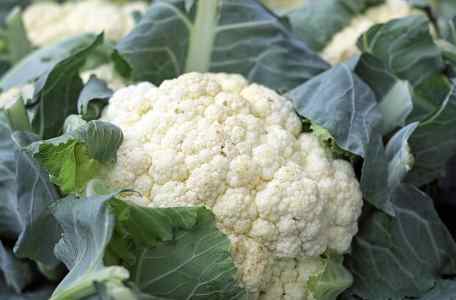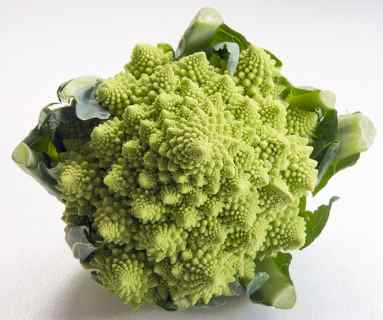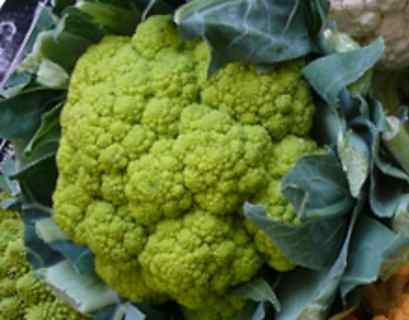Types of Cauliflower: Delicious Cauliflower Varieties From Around the World (With Images)

There are hundreds of varieties of cauliflower that come in various colors. The most common type of cauliflower is the white variety with its distinct ivory-white head and dark green leaves. There are other colored cauliflower varieties that are purple, yellow, orange, and green.
Among these different types of cauliflower are various hybrids with their own unique characteristics. One interesting type of cauliflower is the Romanesco cauliflower which is a green type of cauliflower that may look more like broccoli than a cauliflower.
Cauliflower is a vegetable that belongs to the genus Brassica in the Brassica oleracea species. This means that all types of cauliflower are closely related to broccoli, various types of cabbage, kale, and Brussels sprouts. Cauliflowers also belong to the cruciferous group of vegetables which contain a lot of vitamin C and other nutrients.
In some ways, cauliflower heads resemble those of broccoli, however, there are some differences. Apart from the color difference, cauliflower florets are more closely packed together. In fact, the edible part of the cauliflower head is called the “curd” as it looks like cheese curd. The one type of cauliflower that is close in appearance to broccoli is the ‘Broccoflower.’ This can look either like a green-colored cauliflower or referred also to the Romanesco broccoli variety.
The name “cauliflower” actually means “cabbage flower” in Italian. There are descriptions of cauliflowers from as early as the 1st century A.D. Cauliflower cultivation became popular in Europe during the 16th century and was then introduced to India in the 19th century.
Cauliflowers are a very nutritious type of vegetable. For example, 1 cup of raw cauliflower curd contains over three-quarters of your daily vitamin C requirements and 20% of your vitamin K needs. You also get an impressive 2.5 g of fiber in 100 grams, which is 10% of your daily fiber requirements. (1)
In this article, you will learn about the various types of cauliflower you can buy. You will also find out why colored cauliflower may be healthier for you than the white varieties.
If you grow your own vegetables, you can try growing different colored cauliflowers to add color to your garden and meals. At the end of the article, you will find tips on growing this Brassica vegetable.
Common Types of Cauliflower (With Pictures and Names)
There are hundreds of varieties of cauliflower that come in various colors with white cauliflower being the most popular.
The four main groups of cauliflower are:
- Italian species of cauliflower are the original cauliflower species that include Romanesco and various other colored cultivars.
- Northwest European cauliflowers are cultivars that are ready in the fall and are classed as late harvesters.
- Northern European varieties of cauliflowers are ready to harvest early in the season.
- Asian tropical varieties of cauliflowers are ones that grow well in warm weather.
White Cauliflower
White cauliflower (Brassica oleracea var. botrytis) is generally the type of cauliflower most people think of. Varieties of white cauliflower have a pure white head of flower buds (curd) that is surrounded by green leaves.
There are actually many white cauliflower cultivars that ripen at various times during the growing season. Some popular types of white cauliflowers include some of the following:
Snowball cauliflower has a 6” (15 cm) medium-sized head and is popular in North America. This is a popular home gardener’s variety of cauliflower which has solid, tightly formed white curds.
Snow Spring cauliflower is a cold-hardy cauliflower cultivar which has crispy white curd and a good taste.
White Corona is a small variety of cauliflower whose white head only gets to about 4” – 6” (10 – 15 cm) in size. The pure white florets are delicious raw or in fresh salads.
Early White cauliflower is a fast-growing variety of cauliflower that has a pure white curd and an excellent flavor. The tightly-packed head measures around 9” (22 cm) making this a large variety. The cauliflower cultivar grows well in cool weather and is also a good type of cauliflower to store in the freezer.
Attribute cauliflower hybrid is a medium to large-sized cauliflower that matures early. This variety has a good flavor with a buttery nutty taste. This is a good type of cauliflower to roast, grill, or make cauliflower rice.
Cornish cauliflowers can refer to an ancient cultivar or to cauliflowers grown in the Cornwall area of England. The moderate air temperature in this coastal region is the perfect climate for growing cauliflowers throughout the year.
Romanesco Cauliflower (Romanesco Broccoli)
Also called the Broccoflower, the Romanesco cauliflower is a green variety that has striking florets that give its head a spiky appearance.
Both cauliflower and broccoli are from the same species, Brassica oleracea. This means that it is easy to cross them to develop new cultivars. One of these is the Romanesco cauliflower, also called the Broccoflower or Romanesco Broccoli.
The Romanesco cauliflower is a cultivar from the Brassica oleracea family. In some ways, it looks like a cross between broccoli and cauliflower. It has a lime-green, conical pointy looking head that grows in a spirals. The size of Romanesco heads is similar to a standard cauliflower – about 7” (17 cm) across.
Compared to the common cauliflower, Romanesco cauliflowers have a crunchier texture with a delicate nutty taste. Compared to broccoli, the only real resemblances are the green color and taste. However, this cruciferous green vegetable is more commonly referred to as the Romanesco broccoli.
One of the best ways to enjoy Romanesco as a healthy green vegetable is to separate all the pyramid-like florets, place them on a baking tray, and drizzle with some olive oil. Roast them in a hot oven until the tips of the buds start to turn brown.
You can also enjoy Romanesco cauliflower as you would any other cauliflower – steamed, grilled, or roasted.
Green Cauliflower
Because of its green curd, the Green cauliflower can also be referred to as a broccoflower. This cauliflower cultivar looks like a typical cauliflower but has the color of broccoli.
Apart from its green color, one of the differences between the green and white varieties of cauliflower is their taste. Green cauliflowers tend to have a sweeter and milder taste than their white cousins. This means that if you don’t like the somewhat strong taste of white cauliflower, green varieties may be tastier.
Another way that green cauliflowers and white cauliflowers are different is their texture. White cauliflowers tend to be crumbly which is why they are good for making cauliflower rice. However, green cauliflowers are similar to broccoli in their texture and are more fibrous.
Some popular green cauliflower cultivars include the ‘Alverda,’ ‘the Green Goddess,’ ‘Vitaverd,’ and ‘Chartreuse.’
Purple Cauliflower
Purple cauliflowers are one of the most vibrant and striking large vegetables you will see growing in the garden. The deep purple curd is surrounded by bluish-green leaves. Compared to white cauliflowers, the heads of the purple varieties are tenderer and have a milder taste.
Purple cauliflower cultivars could actually be some of the healthiest cauliflower you can eat. Scientists say that naturally-occurring blue and violet colors come from an antioxidant called anthocyanin. This healthy compound has been linked to reducing cardiovascular disease, inflammation, and the risk of cancer. (2, 3)
Of course, purple cauliflower cultivars also have all the vitamins, minerals, and nutrients found in regular white cauliflowers.
Apart from their better health benefits, one reason to choose purple cauliflowers is that they taste sweeter and nuttier than their white counterparts. Also, steaming, roasting, or simmering some purple cauliflower varieties doesn’t alter their blue-lavender color.
However, some purple cauliflower varieties may turn a light green color when cooked. Try adding some lemon juice while cooking to preserve the deep purple hues.
Here are some of the most popular types of purple cauliflower.
Depurple cauliflower hybrid is a good robust cauliflower cultivar. This purple cauliflower has deep-violet florets with contrasting white stems. The heads of this purple variety grow to between 6” and 7” (15 – 17 cm).
Graffiti hybrid cauliflower is a brightly-colored purple cauliflower that keeps its deep lavender color during cooking. This is a naturally sweet variety of cauliflower that grows well even in humid conditions.
Purple of Sicily cauliflower has deep purple florets making up the medium-sized head. This purple cultivar may turn to light green when it’s cooked.
Sicilian Violet is another example of an Italian/European variety of purple cauliflower that has a vivacious deep lilac color.
Violet Queen produces a cauliflower head that has very deep purple, almost black, florets. This is a cold-hardy type of cauliflower that will withstand temperatures as low as 14°F (-10°C). This type of purple cauliflower is delicious eaten raw or cooked and the leaves are also edible.
Purple Cape cauliflowers produce large purple heads with an excellent flavor. If you are looking for an easy-to-grow variety of cauliflower, then the Purple Cape is one of your best choices.
Orange/Yellow Cauliflower
The orange cauliflower is a cultivar from the Brassica species that has orange or yellow-colored florets making up the head.
Unlike purple cauliflower cultivars that tend to lose their color when cooked, the orange curds usually become more intense in color when cooking.
Compared to the white varieties, orange-colored cauliflowers are much healthier. Their health benefits are due to the levels of beta-carotene in the orange florets. Research has revealed that orange cauliflowers have up to 25 times more vitamin A than white cauliflower. (2)
So, what do orange cauliflowers taste like? Even though they can be called “cheddar” cauliflowers, they don’t taste anything like cheese. Orange-colored cauliflowers have a sweeter and milder taste than white varieties.
Here are some of the best orange / yellow cauliflower cultivars to look out for.
Cheddar cauliflower is one of the most popular varieties of orange cauliflower. This colored cauliflower has a medium-sized head that measures between 4” to 7” (10 – 17 cm). Its mildly sweet taste is more palatable to some than the strong tasting white cauliflower.
Flame star hybrid cauliflowers are a good example of a sweet cauliflower that has a smooth texture. The medium-sized head is firm and dense, and the orange curds become a deeper hue when cooked.
Fioretto Cauliflower
If you are looking for an unusual type of cauliflower, then Fioretto cauliflowers are an excellent choice. Unlike cauliflowers with a large head, this type of cauliflower has white or brightly-colored florets that are on the top of thin green stems.
So, rather than the florets growing into a tightly packed cauliflower head, these florets grow loose. In some ways, this cauliflower variety resembles broccoli rabe or sprouting broccoli.
These floral cauliflower stems make the perfect type of food for dipping with. Another way to try this delicious cauliflower species is to grill or sauté the floral stems. The cauliflower florets and stems stay incredibly crunchy when cooked and they have a mildly sweet taste to them.
How to Choose the Perfect Cauliflower
When choosing the best cauliflower, the most important factors to consider are its color and firmness.
A white variety of cauliflower should have a creamy-white or pure white color. The curds should be free from black marks or spots. Generally, commercially-grown cauliflowers don’t have purple or pink tinges on them. However, if your home-grown cauliflowers have some of this discoloration, it is nothing to worry about.
When choosing colored cauliflowers, look for the vibrancy of color. Purple cauliflowers should be a rich dark purple color, and orange varieties should be a deep orange color.
When buying Romanesco cauliflowers, look for ones that have a yellowish-green color. The curds should be tightly packed together.
When picking any kind of cauliflower, always make sure that the heads (curds) are very firm with no hints of softness.
There is no difference in quality between large cauliflower heads and smaller ones.
Why Can White Cauliflowers Turn Purple Around the Edges?
From all the vegetables in the Brassica oleracea family, cauliflowers can be the most difficult to grow. Cauliflowers prefer cool weather when growing, and too much heat and sun can color the pure white floral heads a purple tinge.
For example, too much sunshine can cause natural pigments in the cauliflower to become more pronounced. This result in white cauliflower heads with hints of pink, purple, or even blue. So, a pink cauliflower is usually just an indication that your cauliflowers are getting too much sun or heat.
To grow pure white cauliflowers, it is necessary to “blanch” them. All this requires is drawing the surrounding leaves up to cover the growing cauliflower head. Secure the leaves together with twine or a rubber band and you should have perfectly white-ivory cauliflowers.
Alternatively, you can buy self-blanching varieties of cauliflowers. The leaves of these cauliflowers naturally wrap over the cauliflower curds to protect them from the sun. Self-blanching types of cauliflower include ‘Snowball’ and ‘Attribute hybrid.’
Of course, if you want to grow a colored cauliflower cultivar, there is no need to blanch them. In fact, exposure to the sun just helps to intensify their colors to produce stunningly colorful cauliflower heads.
Related articles:






